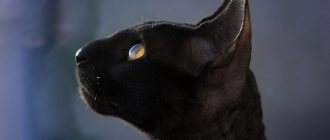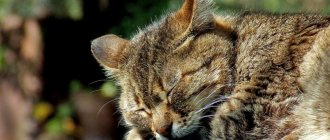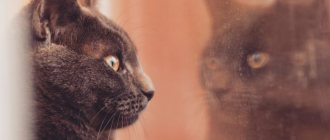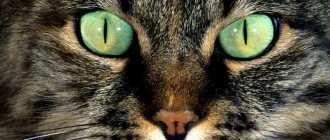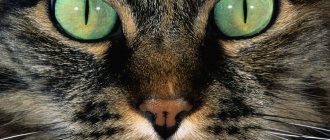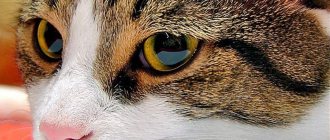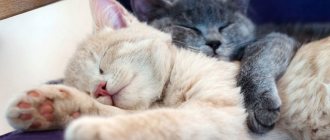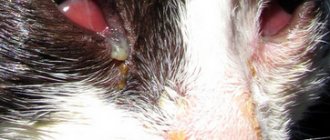07/13/2018 Category: Pets Author: Ekaterina Rogova
The hypnotic gaze of cat's eyes has long bewitched people. In Ancient Egypt, these animals were deified and mummified after death, and in the Middle Ages they were considered minions of the devil, associates of witches and burned at the stake. In the 21st century, prejudices are still alive: some people bring cats with different-colored eyes into their home to attract good luck, others avoid the gaze of their pets at dusk, for fear of causing trouble. And even scientists are still scratching their heads, trying to understand what secrets the cat’s gaze hides.
- 2 Can cats see in the dark
2.1 Video: cartoon about why cats’ eyes glow in the dark
- 5.1 Video: a film for cats starring birds
- 6.1 Video: kittens meet their mirror double
- 7.1 Video: Do cats see parallel worlds?
How many colors can cats distinguish?
It was previously thought that cat reality was black and white, but this is not entirely true. It’s just that the world of Murka is painted in pastel colors and devoid of bright accents. In addition to white, black and twenty-five shades of gray, purrs distinguish between green, blue and yellow, but they do not perceive red and all its variations. Lighting is also important: on a sunny day, yellow appears white to fluffies, and green and blue turn into dark gray at dusk.
Cats may mistake orange for green, and red for dark gray.
This is due to the structural features of the cat's eye. Its retina contains two types of cells - rods and cones. The former are sensitive to light and are responsible for twilight vision, while the latter are involved in color recognition. Nature equipped the cat's eye mainly with rods, allowing it to hunt at night, considering that there was no special need for cones.
If a person has four rods per cone, then cats have as many as twenty-five
I always admire nature, and I still perceive rainbows as a miracle. Previously, I tried to share my delight with my favorite, naively pointing my finger at the sky and persuading her to admire this beauty. But Manya never understood me. Only now it became clear to me that cats simply do not notice the rainbow, because many colors appear to them as different shades of gray. In addition, fluffies do not perceive contrasts well, so faded blue and green stripes against a blue or gray sky run the risk of being overlooked.
Inspiration for inventors
Cat's eyes have served as an example for people to make important inventions. Still would! We don’t have something like that, so we have to come up with something.
Reflector
They say: you see at night like a cat. And it’s not in vain that they say. Cat's eyes glow in the dark because of a special layer called tapetum. It accumulates and reflects sunlight.
In the 30s of the 20th century, the future Commander of the Order of the British Empire, Percy Shaw, invented a reflector for reflectors and called it “cat's eye reflector”. The idea came to him at night when he was drunk and returning from a pub in his own car. Shaw almost drove into a ditch, but a cat sitting on the edge of the road helped. She flashed her eyes and reflected the headlights.
Camera
Many of the functions of the cat's eye formed the basis of the camera.
Perspective. In humans, the viewing angle reaches 160-180 degrees, and in cats it is 185-270 thanks to the huge lens eyes. And don’t be surprised if your cat seems to stare into infinity. She is simply scanning her territory.
Diaphragm. The pupil of cats is capable of narrowing to the size of a slit and expanding to the entire iris. This way they adapt their vision to the intensity of light and avoid burns to the retina.
Shutter and cover. Cats have a third eyelid. This is a milky film that dispenses light, cools and moisturizes the eyes, and also protects against insects.
Can cats see in the dark?
Cats' eyes are unique night vision devices. At dusk, unsurpassed hunters are able to distinguish more than a hundred shades of gray, notice the smallest details of the situation and all the body movements of a potential victim. However, for this, predators still need a light source, for example, the reflection of the moon, a star or a candle flame. In pitch darkness, cats, like people, do not see anything, orienting themselves in space with the help of additional tools - ears, nose and whiskers.
The deficiency of cones in the retina of a cat's eye, responsible for the perception of color, is more than compensated by the abundance of rods, providing highly detailed night images
The ability of purrs to see in semi-darkness is due to the unique structure of their eyes:
- Depending on the lighting, a cat's pupil can expand and contract in a split second. During the day, it resembles a narrow slit about 0.5 mm wide, protects the retina from exposure to sunlight and helps judge distances. In the dark, the pupil enlarges to one centimeter in diameter and absorbs light;
American scientist Martin Banks noticed that the shape of the pupil of representatives of the cat family depends on the method of hunting. Thus, miniature predators that attack their prey from ambush have vertical pupils. Large wild cats - lions, tigers, cheetahs - use their sprinting skills when catching prey, which is why their pupils are always round.
Depending on the time of day and lighting, a cat's pupil can take on the shape of a bead, a rugby ball, or a keyhole. - Behind the retina there is an additional membrane covering the fundus of the eye - the tapetum. Its mirror surface is capable of reflecting light absorbed by the pupil and returning it to the retina. As a result, twilight vision becomes sharper, and the eyes of the murk begin to emit a mystical glow.
Blue-eyed cats scare their owners at night with a red demonic light, and those with amber eyes bewitch them with green.
A special reflective layer - tapetum - helps a cat navigate in twilight fifteen times better than a human
My cat sees perfectly in the dark, performs “feats” every night, and diligently patrols the territory. In the light of day, the beast seems to be replaced: the angel is peacefully basking in the sun, squinting her eyes, or openly sleeping without her hind legs. In rare moments of playfulness, when Manka is hunting for a string that either moves or freezes, her pupils dilate sharply, her gaze becomes playful, she stupidly shakes her head, tries to merge with the floor, simultaneously shuffling her hind legs. This way she demonstrates an extreme degree of interest in the object and meticulously calculates the trajectory of the future jump.
Video: cartoon about why cats' eyes glow in the dark
https://youtube.com/watch?v=5uKqxqsNOgc
The structure of a cat's eye
The mechanism of picture formation is similar in all mammals. Light rays passing through the lens strike the retina and form an inverted image. According to visual impulses, it goes directly to the brain, where it takes on its real position.
Unlike their owners, all cats are predators. The structural features of their visual organ are determined by the need to hunt at night.
Eyeball
The eyeballs of mustachioed pets are less vulnerable. They are deeply set in the skull, protecting them from external influences. The most remarkable thing about them is their size, which increases the viewing angle we are accustomed to. If a person had these, they would resemble oranges 20 centimeters in diameter.
Pupil
Cat pupils can change their shape. In the dark they expand, occupying up to 90% of the space, and in light they narrow into narrow vertical lines. This feature facilitates night vision and provides protection from the sun's harsh rays.
Changing the shape of the pupil also conveys the mood of the animal. Squinting indicates peace and joy, while widening indicates fear and anxiety.
Eyelids
Like dogs, cats have a special nictitating membrane, or third eyelid. It protects the cornea from harmful microorganisms and drying out. You can see it only when the pet sleeps with its eyes slightly open or turns its head at an angle. In other cases, a visible third eyelid is an alarming symptom indicating its loss.
Reflective layer behind the retina
Another unusual organ is the tapetum. This is a special layer of the choroid that acts as a reflector. It redirects even the smallest ray of light outward, illuminating the animal’s path in the dark.
How Far Can Cats See?
Cats are naturally nearsighted. Their visual acuity is only 0.2–0.1, while in a healthy person this value reaches 1.0. The world, more than twenty meters away from the fluffies, is a cloudy and blurry spot. They won’t even be able to see their beloved owner, but they will recognize them by their smell. Cats observe the clearest picture in the range from seventy centimeters to seven meters. This distance is optimal in order to determine the distance and force of the jump to the desired prey during the hunt.
Murkas will also not notice objects located directly under their nose. Their eyes lack the muscles that allow them to adjust the shape of the lens and focus on nearby objects. In such cases, our pets use auxiliary means - smell and touch.
Cats are sensitive to movements, so prey running in a horizontal plane can be noticed at a distance of up to a kilometer, while a potential victim frozen nearby risks being lost sight of. This is explained by the fact that the retina of a cat's eye is richly equipped with rods responsible for recognizing moving objects and the acuity of night vision.
Cats are not able to appreciate all the beauty of the landscape, but objects flickering at some distance will certainly attract their attention. I have been
convinced more than once that cats cannot see well up close. When Manya comes up to me and begs for a forbidden tasty treat with a pleading look in her eyes, I am unable to refuse. I throw her a piece of cheese or sausage, and for a long time she pokes her muzzle into the floor and calls on her sense of smell to help, looking for the long-awaited delicacy. If she notices the treat from afar, then she goes straight to it.
How are cats different from us?
According to scientific publications on the Internet, cats seem to recognize us without our eyesight. In fact, they recognize us by the sound of our voice, smell and touch .
A 2013 study by Japanese scientists found that cats that were played with voice recordings recognized their owner's voice among several foreign voices. Indeed, cats responded to their owner's voice by moving their ears, while they did not react to other voices.
How cats perceive space
Like humans, purrs have binocular (stereoscopic) vision. The two pictures that each eye sees are superimposed on each other, allowing the animal to perceive the world as three-dimensional, accurately determine the shape of objects and the distance to them, which gives a head start on the hunt.
Cat vision allows you to perceive three-dimensional reality
Cats' eyeballs are convex and large, but are located deep in the skull, which limits their movement. Therefore, the animal is forced to turn its head in order to take a closer look at what is happening from the side. But nature compensated for this deficiency by giving cats the “breadth of sight” that peripheral vision provides. The viewing angle available to murks is about 200⁰, while a person sees the world only at 180⁰.
Oriental cats (Siamese, Orientals, Abyssinians), whose eyes are widely spaced, can see space at 270⁰.
Cats see a panoramic picture, although it is rather blurry and faded in the periphery.
Sometimes I approach my cat from the back and, looking into her face from the side, I begin to make frightening grimaces. Manya does not turn her head, but I clearly understand that she is watching me, moving her eyes restlessly and trying to squint them as much as possible. When I make a sharp gesture, she turns around because she can't handle the suspense any longer. Such experiments confirm that cats have a wide viewing angle and are able to notice something looming behind them, but what exactly requires clarification.
Are cats really attached to their owner?
yes : scientifically proven!
Similar to the principle of a child's attachment to its parents, a cat's attachment to its owner develops various characteristic behavioral traits:
- The person who feeds him and takes care of him will reassure him ;
- Thanks to its wild instinct (which is still present even when tamed), the cat will tend to turn away from this person, and this sense of protection will reveal itself to be particularly independent .
- And even if a cat is afraid of leaving or the absence of a calming owner, surprisingly, he still may not be completely sure when he is there, in his presence.
According to a scientific study published in Current Biology, indicators of attachment relationships between cats and humans support the hypothesis that cats demonstrate the ability to bond with a caregiver .
Ce bond of affection between cat and human seems stable and is present even in an adult cat.
How many frames per second can a cat recognize?
Many owners claim that their cats love to watch TV, preferring channels about animals. Small predators freeze at the sight of their wild counterparts, closely follow the flight of birds, and sometimes try to pick them up with their paws. Whether our pets are really watching what is happening on the monitor at this moment or are they attracted by sounds and flickering is an open question.
Video: a film for cats starring birds
The global standard for filming is 24 frames per second, while the mustachioed stripes perceive up to fifty. Therefore, many scientists believe that cats see a set of slides on the screen, i.e., dynamic scenes seem intermittent to them. However, nature films that show 60 frames per second (60 fps) are already available on the Internet. They are the ones who are able to please our pets with a clear, smooth and realistic image.
Cats won't be interested in news - they prefer the action genre
Furry animals and their owners will get the greatest pleasure from watching videos on LCD monitors with 4K resolution and a refresh rate of 120 Hz. In the meantime, such devices have not appeared in every home, some advanced cats are excited to catch virtual mice on the screen of tablets.
I never noticed that my Manya was interested in TV, but for fun I decided to show her a cat video. For some time she watched the fussy movements of birds and rodents and even waved the tip of her tail. I was glad and waited for her to start squeaking pitifully and chattering her teeth, as she always does when she sees living birds. Alas, this did not happen. Literally a minute later, Manya turned away and yawned eloquently.
Video: ginger cat plays with a virtual mouse
Farsightedness
There is an opinion that cats see in the distance as sharply as they see up close. It is not true. Evolution has provided cats with the ability to hunt from cover, so they simply do not need farsightedness. An ordinary mustachioed hunter can distinguish objects at a distance of 20 meters. Anything further doesn't interest her.
It is also noteworthy that cats cannot see well even under their own noses. In order to study objects located less than half a meter from the muzzle, cats use smell and hearing.
What does a cat see in the mirror?
Of course, cats see their own reflection in the mirror, but they do not recognize themselves. The first reaction will depend on temperament: some will want to play with the uninvited guest, others will boldly go into battle, and others will cowardly retreat. But interest and wariness quickly pass, since the animal’s sense of smell and hearing do not provide any additional information about the mysterious stranger.
Kittens usually show curiosity when they see a mirror, but very soon the interest in this piece of furniture evaporates
In ancient times, superstitious people explained the negative reaction of a cat to a mirror by the fact that it sees otherworldly entities in it. In fact, the animal is trying to protect its possessions from the encroachments of the “alien”, who stares straight ahead and arches his back threateningly, therefore posing a challenge.
Only a few representatives of the animal world have the ability to recognize themselves in a mirror image: great apes (orangutans, gorillas, chimpanzees), dolphins, elephants, magpies, stingrays. Children begin to identify themselves at the age of one and a half years.
My cat has never shown any abnormal activity when looking at a mirror. At the first meeting, she only thoroughly sniffed the surface from all sides and immediately forgot about the existence of this object. The creature that Manya saw in the reflection did not impress her at all. Live cats are a completely different matter. From the very first moments, with a guttural growl, she delicately asks them to stay away from her.
Video: kittens meet their mirror double
https://youtube.com/watch?v=xQ9KA2LYJJU
Do cats have an attachment to their owner?
yes : In a sense, because cats feel safe and well with their owner.
Research shows that the human-cat relationship resembles the mother-cat/kitten relationship.
In fact, just as a kitten expects its mother to give it food, all the care, all the love and all the affection it needs, a domestic cat has the same expectations towards the person who cares for it.
And just as the cat/kitten relationship results in very characteristic behaviors (licking, meowing, purring, taste buds, etc.), the cat-human relationship also produces the same behavior.
So, your cat behaves in a relationship with you as with its mother. Therefore, cats see people the way kittens see their mother (protective, caring, calming, reassuring, affectionate, caring...).
But be careful, your cat is not attached to you specifically but to the person who gives him food and pampers him . Indeed, if a stranger comes to your cat overnight with the same attention as you, it is very likely that he will become attached to this person. He will rub his legs, purr on his lap or lick his hands... All those gestures that you thought he reserved for you out of affection for you can quickly be reserved for other people.
In fact, whoever cares for him regularly, the cat will see them as an excellent mother who feeds him every day and gives him affection when he needs it.
This is why the cat is completely different from Jian in that he is loyal and loyal to his master .
Suddenly we may wonder if cats love us and a cat can experience a real feeling of love or if only we really love them?
Do cats see the other world?
Since ancient times, people have believed in the supernatural abilities of cats. It is not for nothing that when moving to a new house, the honorable role of pioneers fell to the lot of the murks. They had to strike up a friendship with the brownie, so that later, in tandem with him, they would protect the home and owners from dangers. In large cities today there are even special companies that rent cats for housewarming for two thousand rubles.
The presence of a cat in the house promises well-being and protects against evil spirits.
Our pets can accurately identify sources of negative energy. For example, those areas of the apartment that attract cats are considered geopathogenic, so it is not recommended to place a bed there. In addition, animals are able to diagnose ailments of internal organs and do their best to heal their beloved owners by lying on sore spots.
Some impressionable cat breeders believe that animals see the souls of the dead or evil spirits when they stare unblinkingly into the void, as if watching someone, or start a sudden game with an invisible man. Skeptics explain this behavior by the presence of well-developed sense organs in cats. If they are able to perceive ultrasound, inaccessible to the human ear, in the nature of which there is nothing supernatural, then they can easily become interested in the rustling sounds coming from the neighboring apartment. Acute twilight vision will help the cat to see in the twilight some flying insect that is invisible to people, and unexpected jumps, somersaults and running will express the purring desire to frolic with a new companion.
A rational explanation for the unusual behavior of a pet does not at all exclude the existence of a parallel reality, because modern quantum physics has long gone beyond traditional ideas about the structure of the universe
Over the 13 years of marriage, I have studied my favorite well. In 99% of cases, all oddities in her behavior can be explained logically. Although one precedent struck fear. One late evening, by the light of a night lamp, my family and I watched a mystical thriller. Everyone was on edge from what was happening on the screen when the dozing Manya suddenly jumped up, bent, fluffed up and stared at the ceiling. From the rush of horror, I broke into falsetto, which further heated the situation. Manya did not take her eyes off the ceiling for a long time and looked around cautiously. The reason for this reaction remained a mystery, but fortunately it was the first and last time. The location of geopathogenic zones in our apartment is also classified, because a lazy and heat-loving cat is only interested in batteries.
Video: Do cats see parallel worlds?
A look at a person
Many people are interested in how cats see our world. But no less interesting is how pets distinguish their owners.
There is a version that to recognize a person, cats use not only vision, but also smell, which helps them put together a more complete picture of what is happening.
As a result of their congenital myopia, cats cannot see details of a human image further than six meters away. Therefore, pets also use their hearing.
Your pet recognizes you not by sight, but by hearing
How do we look in the eyes of a cat? It is believed that animals mistake their owners for their relatives, members of the pack. At the same time, they understand that these relatives are much larger than themselves, and for unknown reasons they also try to look after them.
Ultraviolet perception (UV or black light)
In some ways, cats can see in the dark. A person is not susceptible to ultraviolet radiation (or, as it is also called, black light). Being in a room filled with UV rays, it will seem to him that the room is completely dark - the lens of the human eye will block these light streams. Most mammals, including cats, dogs and monkeys, are designed differently: their lenses allow ultraviolet radiation to pass through. Such a “superpower” could be useful for cats and other predators to track fluorescent traces of animal urine or to recognize camouflaged prey.
This is interesting
Color palette
How many colors can a cat distinguish?
Scientists are still debating how many colors cats see. Some people believe that their color vision is limited to blue and gray. Others say that it looks like a dog's with less saturation and number of shades.
To see the entire spectrum, the human eye uses cones to distinguish three colors - red, blue and green. There are only two cats - blue and green. This is the difference and explanation for the peculiarity of vision. Scientists have conducted many experiments, forcing cats to react to color. They painted what primarily attracts a predator – food and prey. After experimenting, we came to the conclusion that cats see blue and green.
Yellow is a spectrally modified green, which is why cats can distinguish shades of yellow against a green background. But pets see yellow separately as white. Violet is part of the blue spectrum. Therefore, purple objects appear blue to them.
What colors does a cat not distinguish at all?
We can confidently say that cats do not distinguish between three colors at all:
- red
- brown
- pink
To them, these colors look like black and various variations of gray. The perception of the color orange remains a controversial issue.
How does a cat see in the dark?
A wide pupil, a large lens, light-sensitive rods and a light curtain give cats the ability to distinguish objects in the dark 6 to 8 times better than humans. But this does not mean that they can see in complete darkness or distinguish colors at dusk.
Excellent night vision is not without its drawbacks. At dusk, cats see everything in various shades of gray, sometimes with a beige tint. There is no need for a wealth of colors; they successfully hunt by seeing prey in gray tones.
Human vision at night is from above, cat vision is from below
Suggestions that the cat family has infrared or ultraviolet vision have not been confirmed. But how can this be? After all, cats navigate well in pitch darkness and do not bump into surrounding objects. The reason for everything is perfect hearing and mustaches, or rather whiskers, as they are correctly called.
This is a special sensory organ that scans the surrounding space. They help cats move not only in the dark. They successfully compensate for poor vision under their noses by the work of their vibrissae.
How a cat sees humans and the world
Every owner thought about how his pet sees a person and the world. Nothing out of the ordinary, really. Cats see the world the same way people do in low light. Some colors are muted, others look grey, and the picture is a bit dull. Closer to 60 centimeters and further than 6 meters, the silhouettes are blurred.
Cats are born hunters. This causes the perception of the surrounding world
Stationary objects do not attract the cat's attention, but moving objects will always cause a reaction. Therefore, the pet will not notice a large calmly lying owner, and a small bird flying outside the window will instantly arouse keen interest.
For a cat, a person is a gray giant. What size it actually is. And the characteristics of skin and hair color color people in different shades of gray. Colors appear only with clothes.
Video about how cats see:
Peculiarities of color and contrast perception
Compared to humans, color discrimination in cats is much weaker. She distinguishes the contours of objects well, but their colors appear blurry to her, especially at the periphery.
Cat vision occupies an intermediate position between color and black and white. Visual analyzers are insensitive to the average wavelengths of the green part of the spectrum. The whole world is seen in pastel greenish-gray, blue-sand tones, but red, brown and orange are not perceived.
Shades of blue and green appear faded, and purple appears blue. Yellow and blue colors are perceived best by a cat's vision; other shades partially fall out of the picture of the world, being replaced by those closest to them in the color spectrum.
Compared to human eyes, cat eyes not only distinguish shades weaker, but also see everything around them with much less contrast. Their vision is “sharpened” to detect a moving target and correctly estimate the distance to it, which is necessary to calculate the force of a jump during a hunt. Therefore, cats are good at distinguishing moving objects, while stationary ones often escape their attention. For example, an animal may not notice a person standing motionless nearby.
